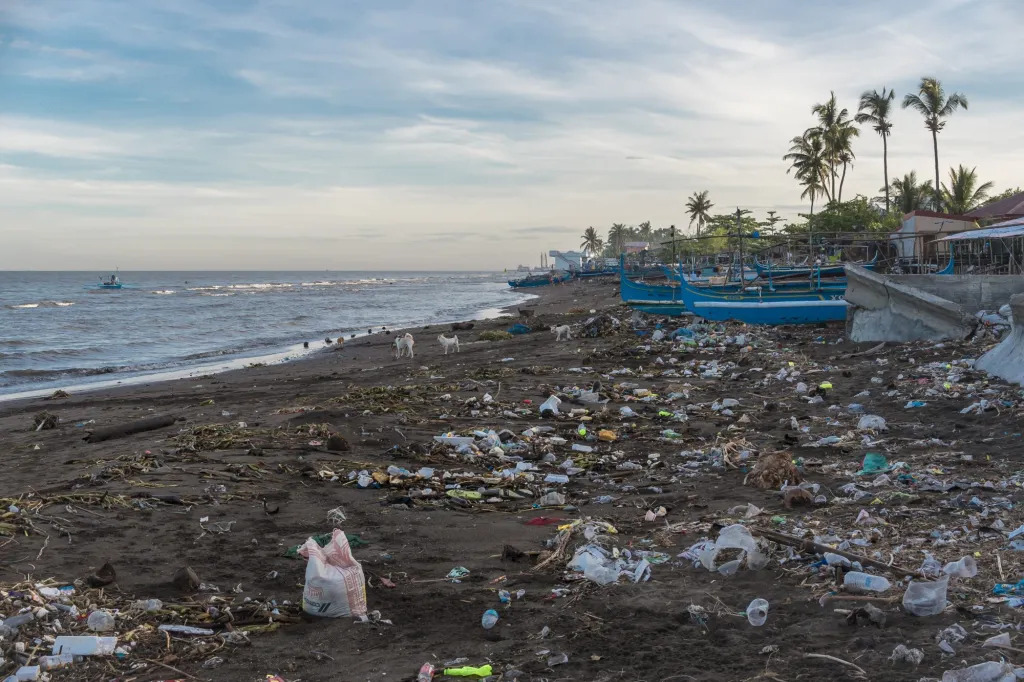
Growing problem
Plastic pollution is a borderless crisis.
Plastics have become so common that it is hard to imagine life without them. They wrap our food, carry our shopping, make up our clothes, and even sit inside our phones and cars. Their light weight and low cost made them a modern wonder.
But today, that wonder has turned into a crisis.
The world produces hundreds of millions of tons of plastic every year, and most of it is used only once before being thrown away. Very little is recycled. Instead, plastics end up piling in landfills, floating in rivers, and breaking down into tiny fragments.
When plastic was first invented in the 20th century, production was tiny. Today it is so massive that scientists warn plastic waste could double by 2050 if nothing changes.
Triple crisis
Triple planetary crisis: pollution, biodiversity loss, and climate change.
- Every year, at least 1,400 wildlife species are harmed by plastic. Birds, turtles, fish and whales swallow it or get tangled in it.
- Around 98 percent of plastics come from fossil fuels. Their production releases massive amounts of greenhouse gases.
- When burned, plastics release toxic smoke and further warm the planet.
- Plastic waste leaks into soils, rivers and oceans. It does not stay in one country but travels across borders, spreading its impact worldwide.
This is why the plastic problem cannot be seen as only a local issue. It is a global crisis that affects health, nature and climate at the same time.
Risks
Food safety: Microplastics have been found in fish, shellfish, salt, and even bottled water. Eating seafood or drinking water may mean swallowing small bits of plastic.
Health risks: While research is still developing, early studies suggest microplastics may cause inflammation, carry toxic chemicals, and enter human tissues.
Local flooding: In many cities, plastic bags block drains and contribute to urban flooding during heavy rains.
Tourism and beaches: Plastic bottles and wrappers on coastlines drive away visitors and affect local economies.
Farming: Farmers often use plastic sheets for crops. Over time, they break down and pollute soils.
Global trade
Plastic is a huge item of trade. Every year, over three-quarters of plastic production crosses borders in some form, whether as raw pellets, packaging, or finished goods.
The total global trade in plastics is worth more than a trillion dollars.
This matters because trade rules shape what kinds of products are cheaper and more competitive. Right now, plastics often have lower tariffs and easier trade rules than their safer alternatives, such as paper or bamboo.
For example, a paper straw can face almost double the import tax compared to a plastic straw. This makes it harder for environmentally friendly products to compete in the market.
Why plastics dominate
Plastics dominate global trade because they are cheap, versatile and durable.
- Cheap production: Falling tariffs and free trade agreements over the past decades made plastic cheaper to move across borders.
- Durability: A plastic bag may be used for only 15 minutes, but it can take hundreds of years to break down in nature.
- Design: Many plastic products are designed for single use, making recycling harder.
In contrast, plant-based or mineral alternatives such as bamboo, jute, paper and glass often face higher trade barriers, making them costlier on shop shelves.
Alternatives
The good news is that alternatives are already available and traded worldwide. People have been using paper, glass, and natural fibers for centuries.
Today, new materials such as seaweed-based packaging or compostable bioplastics are also being developed.
- Paper bags and containers are easy substitutes for plastic shopping bags and boxes.
- Glass bottles can be reused many times without losing quality.
- Bamboo cutlery and straws are growing in popularity.
- Seaweed and other organic materials are being tested as packaging films.
Barriers
- Higher costs: Eco-friendly materials often cost more to produce and buy.
- Infrastructure gaps: Many countries lack facilities to recycle or compost substitutes properly.
- Trade barriers: Paper or bamboo products may face higher tariffs than plastics.
- Consumer habits: People are used to plastic for its convenience and low price.
How it can be changed
- Plastic waste collection and recycling services are crucial for keeping plastics out of rivers and oceans.
- Innovation in design can help make packaging reusable or easier to recycle.
- Digital tracking systems can show where plastics come from and where they end up.
- Extended Producer Responsibility policies make companies pay for the waste their products create, encouraging better design.
Policy steps
Experts suggest six steps that governments can take right now
- Lower tariffs on safe alternatives and review plastics tariffs.
- Invest in recycling systems, waste services, and clean production.
- Align trade and investment policies with the upcoming plastics treaty.
- Use digital tracking and records to monitor plastic waste.
- Improve data collection so decisions are based on reliable evidence.
Real-time examples
- Kenya introduced one of the strictest bans on plastic bags, with heavy fines for violations.
- The European Union banned many single-use plastics, such as cutlery and plates.
Everyday impact
- If shops switch to paper or cloth bags, families bring reusable bags when shopping.
- If recycling is easy and reliable, bottles and containers are returned instead of being thrown away.
- If companies must pay for the waste they create, they will design smarter products with less plastic.
- Cleaner beaches, healthier rivers, and less plastic in food benefit everyone.
Plastic made life easier but created hidden costs for health, climate, and ecosystems. Today, plastic waste contributes to flooding in cities, deaths of marine animals, climate emissions, and even risks to our own health. The problem is global, and so the solutions must also be global. Trade rules, investments, recycling, and consumer habits all need to shift in the same direction.
Plastics will not disappear from our lives completely. They are too useful in medicine, construction and technology. But the way we produce, use and discard them must change.
The choice is whether we continue on the current path of waste and pollution, or whether we build a future where plastic is managed wisely and its harm is reduced.
Reference
- Policy Insights: Mobilising trade to curb plastic pollution
- Plastic bag bans in the US reduced plastic bag use by billions, study finds | World Economic Forum
- EU’s 2025 Plastic Directive Aims To Halve Single‑Use Plastics: What Tableware Makers And Businesses Must Know
- How Kenya’s plastic ban victory became a health crisis | Daily Nation
- Single-use plastics – European Commission


